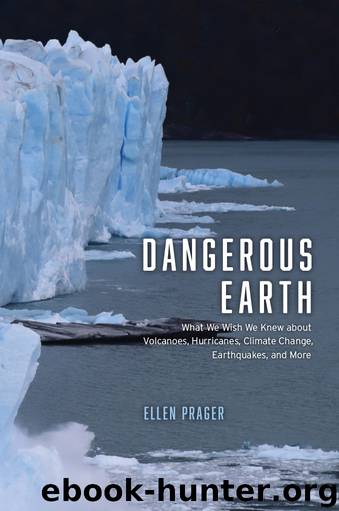Dangerous Earth by Ellen Prager

Author:Ellen Prager
Language: eng
Format: epub
Tags: SCI000000 Science / General
Publisher: University of Chicago Press
Published: 2020-03-02T16:00:00+00:00
Earthquakes: The Unknowns
The Landers Sequence
Before this, no one thought faults could communicate.
—Ross Stein, seismologist
California is a land built, modified, and frequented by earthquakes. In 1992 a series of events there unveiled new information about how earthquakes happen and progress, and raised many new wish-we-knews. They were not the most destructive, deadly, or headline-making earthquakes, but their impact on science was groundbreaking.
On April 23, 1992, a 4.0 magnitude earthquake and several smaller tremors struck the desert region of Southern California’s Joshua Tree National Park. The earthquakes were worryingly close to the infamous San Andreas Fault. But when another earthquake hit later that day, it wasn’t on the San Andreas as feared: it was a 6.1 magnitude event on a smaller fault to the north. It became known as the Joshua Tree event and was followed by a series of strong aftershocks.
Two months later and some 30 kilometers to the north, a cluster of relatively small earthquakes struck near the small desert town of Landers. The following morning Landers was hit again, this time by a major 7.3 magnitude quake. It was the strongest earthquake to strike Southern California in forty years, but because it occurred in a sparsely populated area there was little damage. The earthquake was shallow, only about a kilometer down. The fault rupture associated with it was some 85 kilometers long. But it wasn’t just one fault that tore; the rupture unexpectedly triggered and ripped apart five separate faults, jumping between segments. This significantly increased the size of the quake.
Three hours after the Landers event and 40 kilometers to the west, a 6.5 magnitude earthquake occurred on the Big Bear Fault. Initially, it was described as a separate event or an aftershock, but scientists later realized the Landers event had triggered the Big Bear quake. Not only did the Landers earthquake unexpectedly jump between segments connecting separate faults; it also transferred enough stress to trigger another fault rupture some 40 kilometers away! Tens of thousands of aftershocks followed the Landers earthquake, and seismicity increased in areas as far away as Yellowstone. This was too far for the earthquakes to be considered aftershocks of the Landers event; these distant tremors were also something new—remotely triggered earthquakes.
After the Landers earthquake, seismic activity in the region eventually quieted down. But then, in October 1999, the Mojave Desert was hit again—by the 7.1 magnitude Hector Mine earthquake. Before the main shock, a cluster of smaller earthquakes occurred in the same area as a cluster of aftershocks from the Landers event. The fault rupture in the Hector Mine event was also essentially parallel to the Landers tear. Could the Hector Mine earthquake be strictly coincidence? Scientists no longer think so.
The series of earthquakes associated with the Landers event is now called the Landers Sequence—a series of cascading ruptures with unexpected jumps between faults that increased the magnitude of the event and triggered other earthquakes, some far away. It was a revelation for earthquake scientists and changed their way of thinking about how earthquakes happen and progress.
Download
This site does not store any files on its server. We only index and link to content provided by other sites. Please contact the content providers to delete copyright contents if any and email us, we'll remove relevant links or contents immediately.
Man-made Catastrophes and Risk Information Concealment by Dmitry Chernov & Didier Sornette(5958)
The Revenge of Geography: What the Map Tells Us About Coming Conflicts and the Battle Against Fate by Kaplan Robert D(4053)
Zero Waste Home by Bea Johnson(3809)
COSMOS by Carl Sagan(3593)
Good by S. Walden(3523)
In a Sunburned Country by Bill Bryson(3509)
The Fate of Rome: Climate, Disease, and the End of an Empire (The Princeton History of the Ancient World) by Kyle Harper(3035)
A Wilder Time by William E. Glassley(2837)
Camino Island by John Grisham(2781)
Organic Mushroom Farming and Mycoremediation by Tradd Cotter(2662)
The Ogre by Doug Scott(2659)
Human Dynamics Research in Smart and Connected Communities by Shih-Lung Shaw & Daniel Sui(2479)
Energy Myths and Realities by Vaclav Smil(2464)
The Traveler's Gift by Andy Andrews(2438)
9781803241661-PYTHON FOR ARCGIS PRO by Unknown(2343)
Inside the Middle East by Avi Melamed(2332)
Birds of New Guinea by Pratt Thane K.; Beehler Bruce M.; Anderton John C(2238)
A History of Warfare by John Keegan(2216)
And the Band Played On by Randy Shilts(2169)
